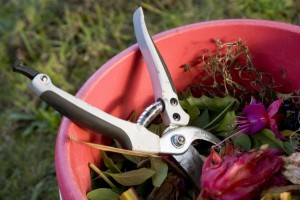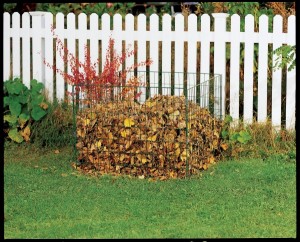The Hoosier Gardener talks about making compost Oct. 28 on Fox 59’s Morning News. You can make compost in a free-standing pile, an enclosed bin or in a specially made composter.
Compost is nature’s way of turning its waste into a earth-enriching product called black gold. The ingredients occur naturally, but it’s a formula that homeowners can duplicate with ease. Think of compost as a recipe with the ingredients listed below. That’s the way the experts say to do it, but honestly, many gardeners, including myself, just pile up the yard debris and let it go, whether in a heap or bin.
Ingredients

Plant clippings that are fresh and green add nitrogen matter to the compost pile. Leaves and dried matter add carbon. (C) iStockphoto.com
Carbon – brown, dried yard waste, such as leaves and clippings.
Nitrogen – green yard waste, such as grass clippings or plant debris and soil, compost or manure. The soil, compost and manure introduces beneficial microorganisms that help break down the yard waste into cmopost.
Moisture – to wet down the pile and help get the process started.
Oxygen – is introduced when you turn the pile. This helps speed up the process. Turn by moving the material on the edges of the pile to the center and the center matter to the edges.
Instructions:
- Layer in carbon materials 8 to 10 inches deep, followed by about 2 to 4 inches of nitrogen materials.
- Moisten the pile.
- Continuing layers these two materials and moistening until the compost pile is about 3 feet tall and wide.
- Allow the pile to rest for a week to 10 days.
- Turn the pile with a garden fork or pitch fork, which work better than a spade or shovel. The more you turn the pile, the faster compost happens. You also can allow the pile to remain passive with no turning, but it may will take six months or more to get compost.
- Spread the compost as needed in the garden or dig it into new beds. It can be used as a mulch around perennials, trees and shrubs.
Other tips:
- Materials used in making the compost pile should be free of chemical pesticides.
- Locate your compost pile on a well-drained site, which would benefit from nutrients running off the pile. A pile exposed to sun tends to heat up faster and make compost quicker than a pile in a shadier location.
- Check with your local health department for community regulations about adding kitchen waste to compost piles.
- Mix the materials thoroughly. Shape the pile so its center is lower than its sides, to help water flow into the pile. Keep the pile moist, but not soaking wet. Within a few days, it should heat up. If not, it may lack nitrogen or moisture.
- When turned, the plant waste should decompose into compost within five months in warm weather, longer under cool or dry conditions, or if the pile is in a shadier area. The center of the pile should reach 160 degrees F to kill most weed seed, insects and eggs, and disease organisms. Composting may be completed in one or two months if the materials are shredded, kept moist, and turned several times to provide good aeration. The smaller the material going into the pile, the quicker it becomes compost.
- You can also add shredded office paper and newspaper, which are considered carbon ingredients.
Resources:



